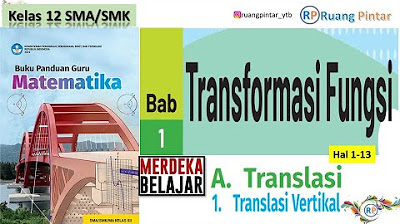CONTOH SOAL DAN PEMBAHASAN TRANSFORMASI LINEAR
Summary
TLDRIn this educational video, the speaker explains the concept of linear transformation using a mathematical example. The focus is on verifying whether a given function, which maps vector spaces, satisfies the conditions of a linear transformation. The conditions discussed are additivity and homogeneity. Through a detailed example, the speaker demonstrates how to check these properties step by step, concluding that the given function is indeed a linear transformation. The video aims to help viewers understand these core concepts in linear algebra.
Takeaways
- 😀 The speaker introduces themselves and the topic of linear transformations in the context of vector spaces.
- 😀 The script explains the basic definition of a linear transformation, which maps a vector space V to a vector space W.
- 😀 A linear transformation must satisfy two key conditions: additivity (F(u + v) = F(u) + F(v)) and homogeneity (F(k * u) = k * F(u)) where k is a scalar.
- 😀 The speaker highlights the importance of understanding these conditions before solving a linear transformation problem.
- 😀 The script provides a step-by-step explanation of solving a problem to check if a given function is a linear transformation.
- 😀 The example problem involves checking if the function F(x, y) = 3x + y - x - y defines a linear transformation from R^2 to R^2.
- 😀 The first condition (additivity) is verified by testing the sum of vectors (u + v) and comparing it with F(u) + F(v).
- 😀 The second condition (homogeneity) is checked by multiplying a scalar k with a vector u and ensuring the result matches k * F(u).
- 😀 The speaker demonstrates the algebraic steps of solving the example problem, including substitution into the function and simplification.
- 😀 After verifying both conditions, the speaker concludes that the function is indeed a linear transformation, as it satisfies both conditions.
Q & A
What is the main topic discussed in the video script?
-The main topic of the video is linear transformations in vector spaces, including an explanation of the definition and properties of linear transformations, followed by an example problem.
What is a linear transformation, according to the script?
-A linear transformation is a function that maps a vector space V into another vector space W, satisfying two main properties: additivity (F(u + v) = F(u) + F(v)) and homogeneity (F(k * u) = k * F(u)), where u and v are vectors and k is a scalar.
What is the first condition a function must satisfy to be considered a linear transformation?
-The first condition is additivity, meaning that F(u + v) must equal F(u) + F(v), where u and v are vectors in the vector space.
What is the second condition for a function to be classified as a linear transformation?
-The second condition is homogeneity, which means that F(k * u) must equal k * F(u), where k is a scalar and u is a vector.
How does the script demonstrate whether the given function is a linear transformation?
-The script demonstrates it by testing the two conditions of linearity. It checks if additivity and homogeneity hold for the given function F(x, y) = (3x + y, x - y) through a series of calculations involving vector addition and scalar multiplication.
What was the function given in the example problem?
-The function given in the example problem is F(x, y) = (3x + y, x - y), where x and y are components of the input vector.
How does the script handle the verification of the additivity condition?
-The additivity condition is verified by considering two vectors, u = (x1, y1) and v = (x2, y2), and checking if F(u + v) equals F(u) + F(v). The script performs the necessary substitutions and calculations to show that the condition holds.
How does the script verify the homogeneity condition?
-The homogeneity condition is verified by testing if F(k * u) equals k * F(u) for a scalar k. The script directly substitutes and calculates to show that the condition holds true.
What conclusion is drawn at the end of the video?
-The conclusion is that the given function is indeed a linear transformation, as it satisfies both the additivity and homogeneity conditions.
What is the significance of the phrase 'Assalamualaikum warahmatullahi wabarakatuh' in the context of the video?
-'Assalamualaikum warahmatullahi wabarakatuh' is a common Islamic greeting, which is used to begin and end the explanation as a sign of respect and courtesy in the context of the video.
Outlines

Cette section est réservée aux utilisateurs payants. Améliorez votre compte pour accéder à cette section.
Améliorer maintenantMindmap

Cette section est réservée aux utilisateurs payants. Améliorez votre compte pour accéder à cette section.
Améliorer maintenantKeywords

Cette section est réservée aux utilisateurs payants. Améliorez votre compte pour accéder à cette section.
Améliorer maintenantHighlights

Cette section est réservée aux utilisateurs payants. Améliorez votre compte pour accéder à cette section.
Améliorer maintenantTranscripts

Cette section est réservée aux utilisateurs payants. Améliorez votre compte pour accéder à cette section.
Améliorer maintenantVoir Plus de Vidéos Connexes

Translasi Vertikal Hal 1-13 Bab 1 TRANSFORMASI FUNGSI Kelas 12 SMA SMK Kurikulum Merdeka

Matematika Kelas 9 Bab 1 Sistem Persamaan Linear Dua Variabel - hal. 2 - 6 - Kurikulum Merdeka

Metode Numerik Pertemuan Regresi Linier

Matrices for General Linear Transformations | Linear Algebra

Menyelesaikan Permasalahan Program Linear Menentukan Nilai Optimum dengan Metode Uji Titik Pojok

Sistem Persamaan Linear Tiga Variabel (SPLTV) membuat model matematika | by Iga Apriliana Mahardika
5.0 / 5 (0 votes)
